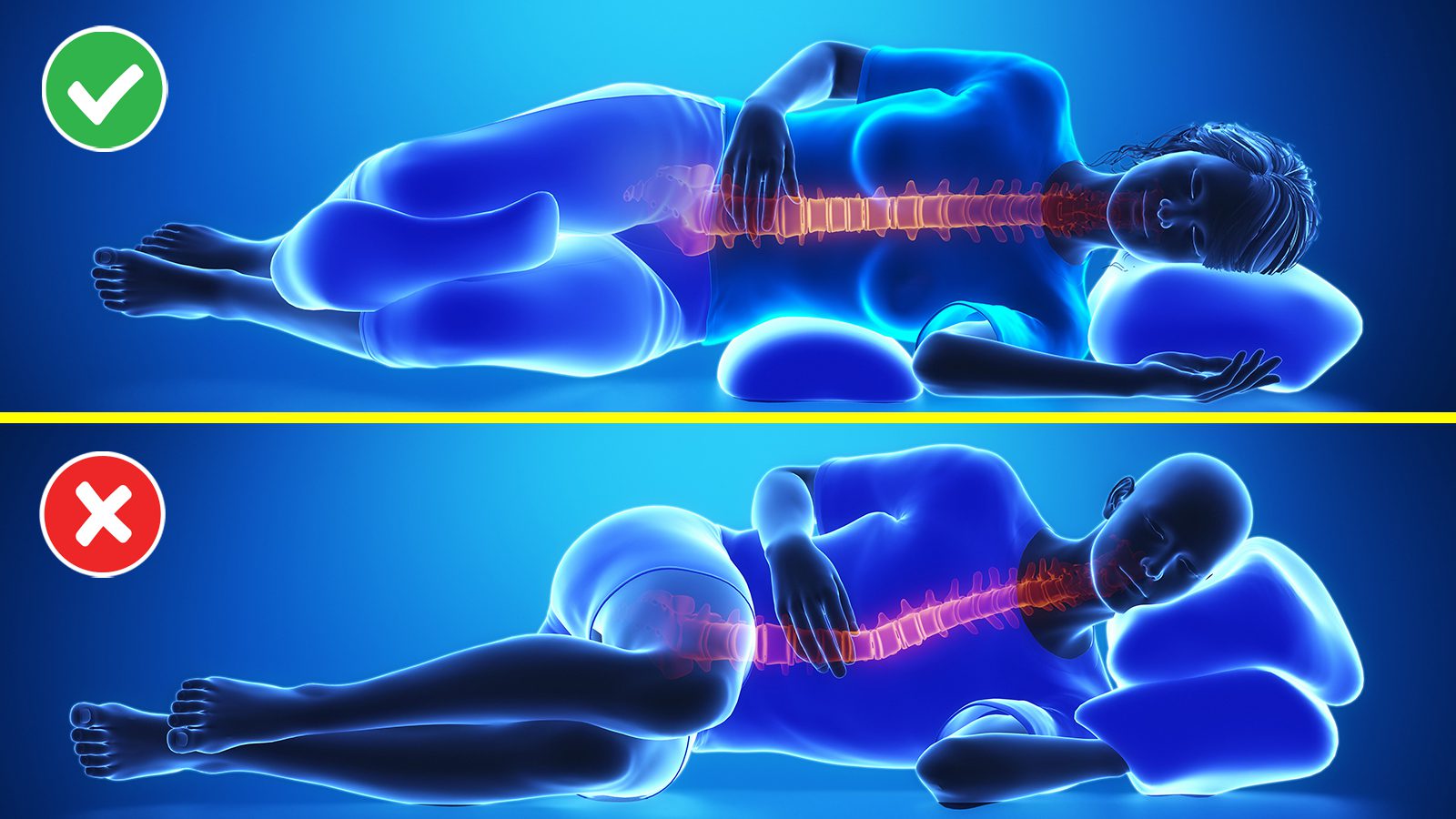Poor sleep posture can leave you exhausted in the morning – know how to fix it.
Medical professionals and sleep experts provide insights into possible solutions and lifestyle changes for improving sleeping posture – and its possible contribution to back pain.
While many people consider posture while working and moving, not everyone considers it during sleep. However, it’s essential to think about it because you’ll spend plenty of time sleeping. It affects your overall well-being and health, so it’s not something you should ignore.
Your sleeping posture impacts your sleep quality and can trigger back pain, snoring, and other issues. Improving sleeping posture for health benefits can make a difference in your life. You’ll wake up feeling rejuvenated and well-rested, so you’ll be ready for your day.
NOTE: Persistent or extreme neck or back pain can be a medical emergency. Your primary care provider or other medical professionals should diagnose or treat it.
Understanding Sleeping Posture
Research shows that people spend one-third of their lives sleeping. So it’s essential to prioritize healthy sleeping positions. It is when your body restores and repairs itself, and how you sleep can boost or disrupt the process. Your posture should allow for the natural curvature of your spine, or you can wake up with aches, pains, and health complications.
Improving your sleeping posture eases spinal stress and helps you get more restful sleep. On the other hand, continuing to sleep in an improper position causes back pain, stiffness, and low sleep quality. The pain and stiffness can occur in your arms, back, or shoulders.
Any sleep position that allows for natural spinal alignment is beneficial and varies depending on what you prefer. Some positions are better than others, with side or back sleeping being the best option.
Sleeping on your stomach isn’t ideal because it doesn’t allow your spine to align. It’s also unsafe for pregnant women and isn’t recommended for anyone with neck or back pain or those concerned about wrinkles.
Importance of Mattress and Pillows
Using the right mattress and pillows can boost your sleep ergonomics and help you feel better when you wake up. You’ll want an orthopedic mattress that allows your hips and shoulders to sink lower than the middle of your spine. It should be a moderately firm mattress because if it’s too soft or firm, it can cause or exacerbate pain.
While you may think pillows are only for your head, you can use them in other areas to promote proper alignment. Using supportive pillows between your knees allows you to keep your hips even. Then, you can put a pillow on each side of your body to prevent movement as you sleep.
When placing a pillow under your head, ensure it supports your spinal alignment. It shouldn’t be too high that it strains your back, neck, and shoulders. Instead, it should allow your neck to align with your lower back and chest.
Sleeping Posture for Back Pain
If you experience back pain, it could be due to your sleep position. You can make some changes to alleviate the pain and feel better daily.
Sleeping posture for back pain requires positioning for adequate lumbar support. It can alleviate the impact of sleeping posture on chronic back conditions. Some methods for avoiding sleep discomfort and back pain include the following:
- Back sleeping: This position is best for alleviating and preventing back pain because it aligns your spine.
- Side sleeping: If you don’t like sleeping on your back, side sleeping is the next best option.
- Avoiding sleeping on your stomach: Sleeping on your stomach is the worst thing you can do to ease back pain.
- Using a body pillow: Placing a body pillow between your knees can help you maintain spinal alignment.
- Supporting your arms: When sleeping on your back, placing a low pillow beneath both shoulders can promote proper alignment.
Sleeping Posture for Breathing and Snoring
Some sleep positions can affect your breathing patterns and cause snoring. It can also lead to sleep apnea.
If you want some sleep apnea and snoring solutions, considering a new sleep position can help. Side sleeping is one position that helps because it helps open your airways, reducing snoring and easing sleep apnea.
Sleeping on your back with your head elevated is another position that can help. It limits airway blockage to minimize snoring and help you get better sleep.
Consult a healthcare professional if changing your position doesn’t help alleviate the issue. It could indicate an underlying sleep disorder that requires medical intervention.
Side-Sleeping Techniques
Studies show that more than 60% of people prefer side sleeping because it’s comfortable for the spine. Side sleeping benefits include the following:
- healthy spinal alignment
- easing back pain
- promoting correct sleeping posture
- reducing heartburn
- easing snoring
- promoting sleep during pregnancy
It’s most beneficial for pregnant women or people with back pain. The left-side sleeping position also eases acid reflux issues and can benefit older people.
Experts indicate that pregnant people should sleep on their left side with their knees bent. It eases pressure on their liver and belly and allows their heart to pump blood. However, they don’t always have to stay on their left side because occasionally switching to the right can relieve left hip pressure.
It helps to put a pillow between your knees when side sleeping to promote spinal alignment. It helps ease back and neck pain and prevents it from reoccurring.
It’s important to note that side sleeping won’t help those with shoulder discomfort, including soreness or tightness. If you’re worried about wrinkles, you may also want to avoid this position because pressing your face into the pillow can lead to stretching and skin compression.
Back-Sleeping Techniques
Sleeping on your back with a pillow beneath your knees reduces stress on your spine. It supports a neutral spine if you follow appropriate head elevation. The pillow you use for your head should support the natural curve of your neck and shoulders rather than only your head.
Back sleeping benefits are better than side-sleeping, although both are good sleeping postures. Being flat on your back makes it easier to distribute body weight and align your spine. It also benefits your skin because your face isn’t pressed into a pillow.
This position helps those with congestion, but you must prop yourself up more. It keeps your airways open and allows your nose to drain better while you sleep. Back sleeping also eases neck pain because it aligns your body better than other positions.
Sleep Hygiene and Habits
Sleep hygiene is the habits that influence your sleep, and they can influence your sleeping posture. It includes following a regular sleep schedule, and a pre-bedtime routine can help. You’ll fall asleep easier and remain resting throughout the night to feel rejuvenated when you wake up.
A pre-bedtime routine helps signal your mind and body that it’s time to rest. Your routine can include anything you want and doesn’t have to match anyone else’s. You might consider:
- writing in a journal
- planning tomorrow’s to-do list
- taking a warm bath or shower
- listening to calming music
- enjoying aromatherapy
- meditating
- repeating affirmations
Another sleep hygiene tip is to focus on good posture throughout the day. While that doesn’t sound like it has anything to do with sleep, it promotes alignment while resting.
Other tips to consider include:
- Being consistent: Prioritize going to bed and waking up at a set time, even if you don’t have anything to do that day.
- Avoiding electronics before bed: Electronics are stimulating and can make it hard to wind down for bed. It might help if you remove them from your bedroom to avoid temptation.
- Limiting naps: Daytime napping can disrupt your sleep schedule and make it hard to fall or stay asleep at night.
- Creating a relaxing sleep space: A quiet, dark, relaxing, and comfortable room can make all the difference in helping you fall asleep.
- Managing stress: Stress can keep you awake at night or disrupt your rest. Finding ways to alleviate it can help improve your sleep hygiene and habits.
Exercises for Better Sleeping Posture
A pre-sleep workout can help you maintain good posture while sleeping. Strengthening exercises can help your core, allowing you to keep good sleeping posture. Stretching exercises can help ease tension so you can sleep better and stay comfortable.
Yoga is beneficial because it can help you get stronger, relax, and ease muscle tension. Some poses to start with include:
- Cat/cow: This pose eases neck tension and helps you relax because it stimulates the vagus nerve. You’ll start on your hands and knees, then lift your head and tailbone toward the ceiling on the inhale. Then, you’ll round your spine towards the ceiling on the exhale.
- Child’s pose: This pose is calming and helps release shoulder tension so you can go to bed comfortably. You’ll stand on your hands and knees, then push your bottom to your feet until you’re sitting on your heels. Then, stretch your arms forward and place your forehead on the floor before taking deep breaths.
These yoga poses aren’t the only exercises you can try for better sleep posture. They are only a starting point to help motivate you.
Final Thoughts on Reducing Neck and Back Pain With Better Sleep Posture
These tips can help you improve your sleeping posture and get better quality rest. Everyone is different, so your ideal position may differ from others. Take the time to find a mattress and pillow that promote proper spinal alignment.
Listening to sleep experts on maintaining proper sleeping positions can make a difference. Consider making lifestyle changes for better sleep posture so you feel better and maintain positive well-being.

















 Community
Community

